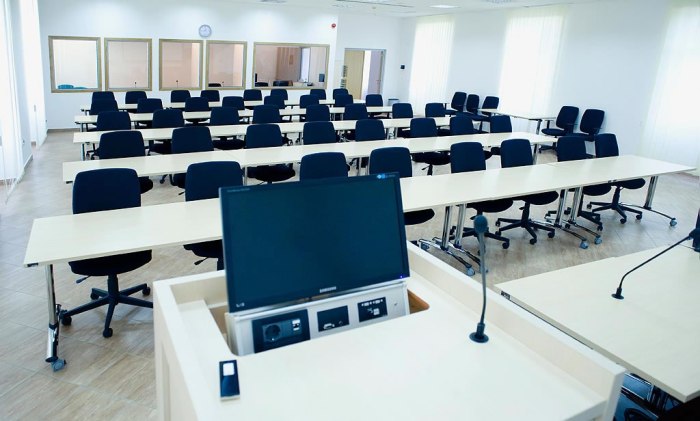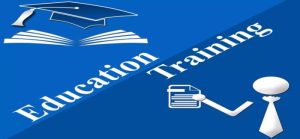
Ever wondered what goes into building a thriving education and training centre? From crafting captivating curricula to mastering the art of marketing, it’s a journey filled with exciting challenges and rewarding triumphs. We’ll delve into the nitty-gritty, exploring everything from designing engaging lesson plans to leveraging technology for optimal learning experiences. Get ready for a deep dive into the world of knowledge creation and dissemination!
This guide unpacks the essential elements of establishing and running a successful education and training centre. We’ll explore curriculum design, facility requirements, marketing strategies, and effective assessment methods. Whether you’re an aspiring entrepreneur, an educator seeking innovative teaching techniques, or simply curious about the inner workings of these vital institutions, this exploration will provide valuable insights and practical advice.
Defining “Education and Training Centre”
An education and training centre is an establishment dedicated to providing structured learning experiences designed to enhance knowledge, skills, and competencies. Its purpose is multifaceted, encompassing individual professional development, workforce upskilling, and the advancement of specific industries. The target audience is incredibly diverse, ranging from school leavers seeking vocational training to experienced professionals looking to refresh their skillset or acquire new qualifications.
Typical offerings include workshops, seminars, online courses, apprenticeships, and degree programs, all tailored to meet the needs of the learners and the demands of the market.Education and training centres vary considerably in their focus and approach.
Types of Education and Training Centres
The spectrum of education and training centres is broad. Some specialize in highly technical fields like engineering or software development, offering advanced certifications and industry-recognized qualifications. Others might focus on softer skills, such as leadership, communication, or project management, catering to a broader range of professionals across various sectors. Further distinctions can be made based on target demographics.
For instance, some centres might specialize in training young adults for entry-level positions, while others focus on executive education for senior management. Finally, some centres are affiliated with specific industries or organizations, providing bespoke training programs to meet their unique needs. For example, a large manufacturing company might operate its own training centre to ensure its workforce has the necessary expertise to operate its machinery and maintain high production standards.
Conversely, a completely independent centre may offer general courses applicable across numerous fields.
Characteristics of Successful Education and Training Centres
Several key factors contribute to the success of an education and training centre. A successful centre prioritizes high-quality instruction, utilizing experienced and knowledgeable instructors who are adept at engaging learners and fostering a positive learning environment. Curriculum design is another critical aspect. Effective programs are relevant, up-to-date, and aligned with industry best practices. They incorporate practical, hands-on components whenever possible, maximizing the transfer of knowledge to real-world applications.
A strong emphasis on assessment and feedback ensures learners are tracking their progress and identifying areas for improvement. Finally, successful centres foster a culture of continuous improvement, regularly evaluating their programs and adapting them to meet evolving learner and industry needs. For example, a successful centre might regularly update its course materials to reflect changes in technology or industry regulations, demonstrating a commitment to providing its students with the most current and relevant skills.
Conversely, a centre that fails to adapt to these changes risks becoming obsolete and losing its competitive edge. Accessibility, including online learning options and diverse learning formats, also contributes significantly to success.
Curriculum and Course Design
Crafting a successful education and training centre hinges on a well-structured curriculum and thoughtfully designed courses. A robust curriculum not only Artikels the knowledge and skills to be acquired but also dictates the learning journey, ensuring a smooth and effective transition from novice to proficient. This involves careful consideration of learning objectives, assessment methods, and the overall learning experience.
Sample Curriculum: Cybersecurity Fundamentals
This curriculum focuses on providing a foundational understanding of cybersecurity principles and practices. It’s designed for individuals with limited technical experience aiming to enter the field or enhance their existing knowledge.
| Course Name | Description | Objectives | Assessment |
|---|---|---|---|
| Introduction to Cybersecurity | Overview of cybersecurity threats, vulnerabilities, and best practices. Covers basic concepts like confidentiality, integrity, and availability. | Understand fundamental cybersecurity concepts; identify common threats and vulnerabilities. | Quizzes, participation in discussions. |
| Network Security | Explores network security protocols, firewalls, intrusion detection systems, and VPNs. | Explain network security protocols; configure basic firewall rules; identify and mitigate network-based threats. | Practical exercises, lab assignments, final exam. |
| Operating System Security | Focuses on securing operating systems (Windows and Linux) through user account management, patching, and access control. | Configure secure user accounts; implement patching strategies; understand and apply access control principles. | Practical exercises, lab assignments, final exam. |
| Security Awareness and Best Practices | Covers topics like phishing, social engineering, and password management. | Identify and avoid common social engineering tactics; implement strong password management practices; understand the importance of security awareness training. | Quizzes, scenario-based exercises, presentations. |
Facilities and Resources

Creating a thriving education and training centre requires a strategic blend of physical infrastructure, technological tools, and rich learning resources. A well-designed environment fosters engagement, collaboration, and ultimately, successful learning outcomes. Let’s explore the essential components that contribute to a truly effective learning space.
Ideal Physical Infrastructure
The physical layout of an education and training centre significantly impacts the learning experience. Careful consideration of classroom design, lab spaces, and accessibility features is crucial to create an inclusive and productive environment. A well-designed space promotes both individual learning and collaborative work.
- Classrooms: Modern classrooms should be flexible and adaptable, moving away from the traditional lecture-style setup. Think modular furniture, interactive whiteboards, ample natural light, and comfortable seating arrangements that encourage active participation. Consider incorporating breakout spaces within the classroom for small group activities.
- Laboratories: For practical training, dedicated labs are essential. These spaces need to be equipped with the appropriate tools, machinery, and safety equipment relevant to the courses offered. The design should prioritize safety and easy access to resources.
- Accessibility: Universal design principles must be at the heart of the physical infrastructure. This includes features like ramps, elevators, accessible restrooms, and assistive technologies to cater to learners with disabilities. Clear signage and wayfinding are also critical for easy navigation.
- Common Areas: Designated areas for relaxation, socializing, and informal learning are vital. These spaces could include comfortable lounges, study areas, and outdoor spaces to encourage interaction and a sense of community among learners.
Technological Resources
In today’s digital age, technology plays a pivotal role in enhancing the learning experience. A modern education and training centre needs to be equipped with a range of technological resources to support both instructors and learners.
- Learning Management Systems (LMS): An LMS is the central hub for course delivery, communication, and assessment. Popular platforms like Moodle, Canvas, and Blackboard offer features such as online course content, assignment submission, grading tools, and communication forums. A robust LMS streamlines the administrative tasks and enhances the learning experience.
- Software Applications: Depending on the courses offered, specific software applications are essential. This might include design software (Adobe Creative Suite), programming languages (Python, Java), statistical software (SPSS, R), or specialized industry-specific applications. Access to these applications is crucial for hands-on learning.
- Hardware: Reliable hardware is fundamental. This includes computers, laptops, projectors, interactive whiteboards, high-speed internet access, and potentially specialized equipment depending on the courses (e.g., 3D printers, virtual reality headsets). Regular maintenance and updates are vital to ensure optimal performance.
- Audio-Visual Equipment: High-quality audio-visual equipment is crucial for effective presentations, lectures, and online learning sessions. This includes projectors, speakers, microphones, and webcams for clear communication and engaging learning experiences.
Library Resources and Learning Materials
A comprehensive collection of learning resources is crucial for supporting in-depth learning and independent study. The library serves as a vital repository of knowledge, providing learners with access to diverse materials.
- Physical Books and Journals: A well-curated collection of relevant textbooks, reference books, and journals provides learners with a foundation of knowledge and access to current research in their fields of study.
- Online Databases and E-Resources: Subscription to online databases, e-books, and journals expands the scope of available resources significantly, offering access to a wider range of information and research articles beyond what is available physically.
- Digital Archives and Multimedia Resources: Access to digital archives, videos, podcasts, and interactive simulations enhances the learning experience by offering diverse formats of information catering to different learning styles.
- Specialized Software and Training Materials: Access to software tutorials, training manuals, and industry-specific documentation complements practical training and enhances skill development.
Marketing and Outreach

Getting the word out about your fantastic education and training center is crucial for success. A well-defined marketing strategy will attract the right students and ensure your center thrives. This involves understanding your target audience, choosing the right marketing channels, and crafting compelling messaging that resonates with potential learners.A robust marketing plan is more than just advertising; it’s about building a strong brand and creating a community around your center.
It’s about showcasing the value you provide and establishing your center as the go-to place for high-quality education and training.
Target Audience Identification
Identifying your target audience is the cornerstone of any successful marketing campaign. Understanding their demographics, learning styles, career aspirations, and motivations will allow you to tailor your message and choose the most effective channels to reach them. For example, a center offering coding bootcamps would target young adults interested in tech careers, while a center specializing in professional development might focus on working professionals seeking career advancement.
Consider factors like age, income level, education level, location, and even their online behavior to create detailed buyer personas. This will help you to create more effective marketing materials.
Marketing Channels
The channels you use to reach your target audience should align with their preferences and behaviors. A multi-channel approach is usually most effective. This could include:
- Website: A user-friendly website with clear course information, testimonials, and online registration is essential. Imagine a clean, modern website with high-quality images showcasing your facilities and instructors. The website should be optimized for search engines () to improve its visibility.
- Social Media: Platforms like Facebook, Instagram, LinkedIn, and even TikTok can be powerful tools for reaching specific demographics and engaging potential students. Think engaging videos showcasing student success stories or behind-the-scenes glimpses of your center’s vibrant learning environment.
- Email Marketing: Building an email list allows you to directly communicate with potential students, sharing course updates, promotions, and valuable content. Visualize a newsletter showcasing upcoming courses, student testimonials, and links to helpful resources.
- Partnerships: Collaborating with local businesses, schools, and community organizations can expand your reach and credibility. Consider partnerships with local employers who might sponsor training programs or hire your graduates.
- Print Advertising: While digital marketing is crucial, print advertising (flyers, brochures, newspaper ads) can still be effective, particularly for reaching older demographics or those less reliant on digital platforms. A visually appealing brochure highlighting your key courses and benefits would be a good example.
Marketing Messaging
Your messaging should clearly communicate the value proposition of your education and training center. What makes you unique? What results can students expect? Focus on the benefits, not just the features. For example, instead of saying “We offer welding courses,” you could say “Launch your welding career with our expert instructors and hands-on training.
Graduate job-ready and confident.”
Sample Marketing Materials
A compelling brochure could feature stunning visuals of your facilities and instructors, alongside testimonials from satisfied students. It should clearly Artikel your course offerings, highlighting key features and benefits. Website copy should be concise, engaging, and informative, using strong calls to action (e.g., “Enroll Now,” “Request a Brochure”).
Social Media Strategies
Social media provides a powerful platform for engagement. Post regularly, using a mix of content formats (images, videos, text updates). Run contests and giveaways to increase engagement. Share student success stories and testimonials to build credibility. For example, a post featuring a graduate who landed a dream job after completing a course at your center would be highly effective.
Utilize relevant hashtags to expand your reach. Consider running targeted ads to reach specific demographics. Consistent posting and engagement are key to success.
Assessment and Evaluation
Effective assessment and evaluation are crucial for any successful education and training center. They provide valuable insights into learner progress, program effectiveness, and ultimately, the return on investment. A robust assessment strategy ensures that learning objectives are met and that the training program is delivering the expected outcomes.
Assessment Methods
Choosing the right assessment methods is key to accurately gauging learner understanding and skill acquisition. Different methods cater to various learning styles and program objectives. The following table Artikels several common approaches:
| Method | Description | Advantages | Disadvantages |
|---|---|---|---|
| Written Examinations | Tests, quizzes, and essays designed to assess knowledge and comprehension. | Cost-effective, easy to administer to large groups, objective scoring possible. | May not accurately reflect practical skills, susceptible to test anxiety, can be easily memorized without true understanding. |
| Practical Assessments | Hands-on activities, simulations, and projects that evaluate practical skills and application of knowledge. | Directly assesses competency, provides real-world application context, identifies skill gaps. | Can be time-consuming and resource-intensive, requires careful observation and evaluation, may be subjective depending on assessor. |
| Observations | Directly watching learners perform tasks or participate in activities. | Provides real-time feedback, identifies areas for improvement, can be used in various settings. | Can be subjective, requires trained observers, time-consuming, may influence learner behavior. |
| Portfolios | Collections of learner work showcasing skills and progress over time. | Demonstrates growth and development, allows for self-reflection, showcases diverse skills. | Time-consuming to create and assess, requires clear guidelines and criteria, may not be suitable for all learning outcomes. |
| Self-Assessments | Learners reflect on their own learning and progress. | Encourages self-reflection and metacognition, identifies areas of strength and weakness, promotes learner autonomy. | Can be subjective, may lack objectivity, learners may overestimate or underestimate their abilities. |
Feedback Mechanisms
Providing timely and constructive feedback is paramount to learner success. Feedback helps learners understand their strengths and weaknesses, guiding them towards improvement. Effective feedback strategies include:
Effective feedback should be specific, actionable, and focused on the learner’s performance, not their personality. For example, instead of saying “Your presentation was terrible,” a more constructive approach would be “Your presentation lacked clear transitions between points. Consider using visual aids to improve clarity and flow.” Regular feedback loops, incorporating both formative (during the learning process) and summative (at the end of the learning process) assessments, maximize learning impact.
Return on Investment (ROI) Measurement
Measuring the ROI of education and training programs demonstrates their value and justifies continued investment. This can be achieved through various methods, including:
ROI is typically calculated by comparing the costs of the training program (including instructor fees, materials, and administrative costs) against the benefits it generates. These benefits can include increased productivity, improved employee performance, reduced errors, higher employee retention rates, and increased sales or revenue. For instance, a company might invest $10,000 in a sales training program. If the program leads to a $50,000 increase in sales, the ROI would be 400% (($50,000 – $10,000) / $10,000
– 100%).
Tracking key performance indicators (KPIs) before, during, and after the training program is essential for accurate ROI calculation. This could involve measuring employee performance metrics, customer satisfaction scores, or sales figures.
Education and Training (Specific Focus)
The modern job market is a dynamic and ever-evolving landscape, demanding a workforce equipped with adaptable skills and continuous learning capabilities. This section delves into the shifting paradigms of education and training, comparing traditional and online models, and emphasizing the critical role of lifelong learning in navigating this ever-changing professional environment.
The Evolving Landscape of Education and Training
The traditional model of education, characterized by structured classroom learning and standardized curricula, is undergoing a significant transformation. Technological advancements, globalization, and the increasing demand for specialized skills are driving the need for more flexible, personalized, and outcome-focused learning experiences. We’re seeing a rise in micro-credentials, bootcamps focusing on in-demand tech skills, and competency-based training programs that assess learning based on demonstrable skills rather than solely on time spent in a classroom.
The focus is shifting from simply acquiring knowledge to developing practical skills applicable to real-world scenarios. For example, the rise of data science has led to numerous short-term intensive training programs offering certifications in data analysis and machine learning, catering to the immediate needs of the industry. This contrasts sharply with the traditional four-year university degree, which, while valuable, may not always directly address the rapidly evolving skill sets needed in the tech sector.
Traditional and Online Education and Training Models
Traditional education, often associated with face-to-face instruction in classrooms or lecture halls, offers benefits such as direct interaction with instructors and peers, fostering collaboration and a sense of community. However, it is often inflexible, geographically limited, and can be expensive. In contrast, online education and training leverage technology to deliver learning materials and assessments remotely. This offers flexibility in terms of time and location, accessibility to a wider audience, and often a lower cost.
However, online learning requires self-discipline and strong technological literacy. The lack of face-to-face interaction can hinder collaboration and potentially limit opportunities for immediate feedback from instructors. A successful blended learning approach, combining the strengths of both models, often proves to be the most effective. For example, a university course might incorporate online lectures, supplemented by in-person workshops and group projects.
The Importance of Continuous Professional Development and Lifelong Learning
In today’s rapidly changing job market, continuous professional development (CPD) and lifelong learning are not merely desirable, but essential for career success and personal fulfillment. The half-life of skills—the time it takes for skills to become obsolete—is decreasing, meaning professionals need to constantly update their knowledge and skills to remain competitive. CPD encompasses a wide range of activities, including formal training courses, workshops, conferences, mentoring, and self-directed learning.
Lifelong learning embraces a broader perspective, encompassing the pursuit of knowledge and skills throughout one’s life, both for professional advancement and personal enrichment. For instance, a software engineer might participate in online courses to learn new programming languages or attend conferences to stay abreast of industry trends. This proactive approach to learning ensures they remain valuable and adaptable in their field.
Investing in CPD and embracing lifelong learning is an investment in oneself and future career prospects.
Final Summary
Building a successful education and training centre is a dynamic process that requires careful planning, adaptability, and a genuine commitment to fostering learning. From crafting engaging curricula and leveraging technology to building a strong brand and measuring impact, every element plays a crucial role in achieving success. By understanding the key components discussed here—curriculum design, facility management, marketing strategies, and effective assessment—you can create an environment that empowers individuals to reach their full potential.
So, are you ready to embark on this exciting educational adventure?
Key Questions Answered
What accreditation is needed to operate an education and training centre?
Accreditation requirements vary widely depending on location and the type of training offered. Research your local and national regulations to understand necessary certifications and licensing.
How do I attract students to my education and training centre?
A multi-pronged approach is key: targeted online advertising, strong social media presence, partnerships with local businesses, and word-of-mouth referrals from satisfied students.
What is the average cost of setting up an education and training centre?
Start-up costs depend heavily on location, size, and the type of training provided. Expect significant investment in facilities, equipment, marketing, and instructor salaries.
How do I measure the success of my education and training programs?
Track key metrics such as student satisfaction, job placement rates (if applicable), and learner skill development. Gather feedback through surveys and assessments.





